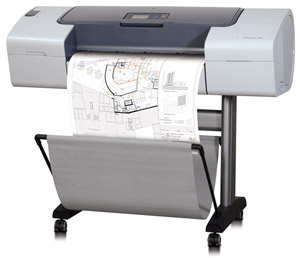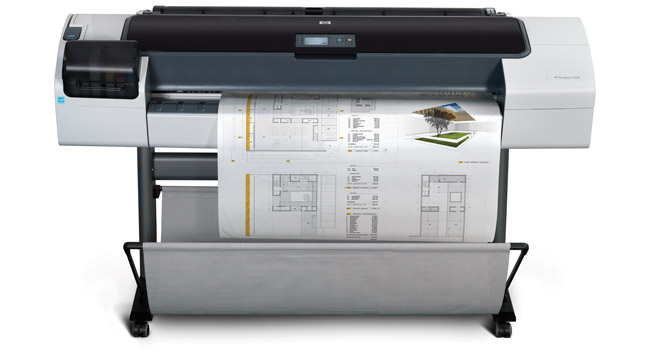HP’s new whisper-quiet DesignJet T1200 offers production-level features in a workgroup printer. With two rolls it can deliver linework drawings and photorealistic renderings without having to swap over media, writes Greg Corke.
Despite the move to digital workflows the A0 printed drawing still has an important role to play in design and engineering. It allows project participants to see both the big picture and details at the same time helping highlight nuances of a design that simply would not have been seen before.
Of course, the maturation of 3D CAD and all the stunning design visualisations that are born out of it has had a major impact on what we print. In architecture, for example, line drawings, complex 3D renderings and fine text all sit together on the same sheet to help sell concepts and win projects. Rendered details are also more appealing and help the non-expert understand the project. This is true for all areas of design.
Product information
Product: DesignJet T1200
Supplier: HP
Price from £4,635
www.hp.com/designjet
With the exception of Océ’s ColorWave technology, in order to mix all of these graphic elements on a single printed sheet, inkjet continues to be the technology of choice.
HP has dominated the wide format inkjet market for many years and its DesignJet brand has stood firm for over 20 years. The key to its success has been consistent innovation, not only in relation to print speed and quality, but also in terms of ease of use and overall productivity.
With a view to taking small to medium workgroup printing to the next level HP has just announced a complete overhaul of its technical range of DesignJets.
Heading up the new range is the two roll DesignJet T1200, a 44-inch (A0+) printer designed for workgroups of 10 or more users.
Designed as a direct replacement to the DesignJet T1120, there are many welcome enhancements, primarily to enable longer unattended printing, but also to enhance productivity in a networked environment, so let us look at each of these in turn.
Two roll printing
In a workgroup environment, managing the output of linework and photo quality prints is not easy. For high-quality photorealistic renderings, special photo paper is required, but this is too expensive to use all day long if a big proportion of your output is plans and elevations.
As workgroup printers traditionally only have one roll, to use a single machine for this dual purpose requires careful monitoring to ensure people do not send linework print jobs when photo paper is loaded. It also means downtime when rolls have to be changed. The T1200 overcomes this by supporting two rolls, a first for HP in its workgroup product range. Users can submit both types of jobs and the system will automatically swap between rolls, all in a matter of seconds. As with all printers, this process can occasionally fail, but HP boasts a 99.97% reliability rate for its DesignJet T1200.
In addition to offering two roll printing as standard, the DesignJet T1200 can also accept single sheets, which increases the flexibility yet further. For example, workgroups could install an A1 and A0 roll of standard coated paper, with one off photo quality prints loaded in sheets.
Memory
Featuring 32GB of dedicated file processing memory, this is a huge step up for HP’s medium workgroup printer. It means that when data is output directly from a CAD system in HPGL/2 or a vector-based PDF file is sent, all of the raster processing is done on the printer and not on the workstation that submits the job.
As vector data is much smaller than raster data, this can significantly reduce network traffic, up to 50 times in some cases, says HP. This is significant, even on Gigabit Ethernet, which comes standard on the T1200.
In-printer processing also decreases the load on the CAD workstation, both in terms of CPU and memory. During development HP threw a combination of complex linework, text, renderings and photos at the printer, but says it has yet to find a file it could not handle.
Of course, as the DesignJet T1200 is a network printer, multiple print jobs can be queued up and stored on the in-built 160Gb hard drive. And for those worried about data security a removable hard drive, that can be locked in a safe overnight, is available as an option.
Noise
While this is something most users take for granted when using a large format machine, print noise can be very distracting in a workgroup environment. During the development of the new DesignJets, HP undertook an extensive research project to find the exact source of the noise. Then, by refining various components and the use of new materials, managed to reduce the operation noise by four times (or 11 decibels) when compared to its previous model. According to HP, this is the equivalent of the sound of a TV compared to a modern fridge on standby. Analogies aside, we found the printer to be incredibly quiet in use — maybe even too quiet for those that like a bit a background noise in their office environment!
Ink
As with the previous generation DesignJet T Series printers, the T1200 features three blacks. This means traditional matt black for line drawings, photo black for true black on glossy paper and a separate grey to help achieve better grey tones. With one eye on creating a workhorse linework printer, the ink capacity of the matt black cartridge has been increased to 300ml. The other blacks and Cyan, Majenta, and Yellow remain in cartridges of 130ml or 69ml.
Quality and speed
In relation to its predecessor, the T1120, the DesignJet T1200 boasts a slight increase in print speed printing an A1 line drawing in Economode (draft) in 28 seconds. This is compared to the 35 seconds it takes on the T1120. The quality of Economode is quite impressive for a draft mode and perfectly acceptable for design/review.
Naturally, print quality varies greatly according to the media used. Line drawings appear crisp, but not supersharp, on HP’s Universal bond paper (80g/m2). For a combination of incredibly sharp lines and rendered details HP’s new cockle-free coated paper (100g/m2) delivers excellent results, but for photo quality renderings its universal high-gloss photo paper (190g/m2) delivers truly stunning results. Prices start at £11, £26 and £60 respectively. Of course, with its two rolls and sheet feed on the DesignJet T1200 it is incredibly easy to mix these media types.
Instant Print 3.0
HP’s InstantPrint utility provides non-technical users with a simple utility for printing large format without having to open the file.
The software supports a number of file formats, including PDF, PowerPoint, and HPGL/2, but for version 3.0 this has now been extended to Word, Excel, TIF, JPG and most interestingly for Autodesk users, DWF, which is supported in all Autodesk applications. The new version also allows users to print straight from attachments in Outlook, so there is no need to save to the desktop first.
Printing from HP’s Instant Print Utility is as simple as right clicking on one or more files, choosing an installed printer and selecting print. The system can auto-scale, auto-rotate, and offers real-time print preview so you can see exactly how it will fit on the sheet — or not as the case may be.
For files that are scaled, a watermark can be automatically added to warn users not to take direct measurements off the drawing. The system can also be configured so prints are never scaled and will warn users if they will not fit on the paper loaded into a machine. When printing multiple copies of multiple drawings the software can auto collate so you do not have to sort out into groups. Finally, a job accounting ID can be included for project or customer cross charging.
Version 3.0 has just been released and the good news is it works with virtually all DesignJet printers, old and new. It is a free download from HP’s website.
Conclusion
Despite being classified as a workgroup printer, HP’s DesignJet T1200 is starting to take on many of the characteristics of a production level machine and when it comes to its substantial 32Gb of memory surpasses them.
The most significant development is the provision of two rolls. Historically, many firms have needed two printers — one for high throughput line drawings and the other for occasional premium quality photo output. While most modern inkjets can support both types, swapping rolls and making sure submitted jobs get printed on the right media is often hard to juggle.
The DesignJet T1200 solves this problem and this, along with its ability to process large files efficiently and print quietly, is an exciting new development in wide format workgroup printing.
The T1200’s younger siblings

In addition to the DesignJet T1200, HP has also launched the A0+ DesignJet 770 and the A1+ DesignJet T620, both targeted at smaller workgroups.
Featuring the same print speed as the DesignJet T1200, the DesignJet T770 is similar in many ways. The main differences are it only has a single roll and features 8GB memory instead of 32GB. While this is still plenty of memory for most print jobs, those printing high-res photo images may find the processing is pushed back to the workstation during peak loads. Other differences include 100Mb Ethernet instead of Gigabit and all of its cartridges are 130ml or 69ml. The DesignJet T770 starts at £2,852 (£3,610 with a hard drive), compared to the DesignJet T1200, which starts at £4,635.
The smallest addition to the new DesignJets is the A1-sized T620. This is virtually identical to the T770, but has a slightly slower print speed of 35secs per A1 and is not as quiet — 57db compared to 46db. Or to borrow HP’s analogy, a TV compared to a fridge. The DesignJet T620 costs £1,837.






